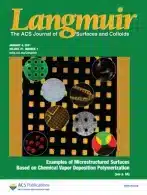
Randall M. Stoltenberg,† Chong Liu,‡ and Zhenan Bao
Abstract
Developing orthogonal surface chemistry techniques that perform at the nanoscale is key to achieving precise control over molecular patterning on surfaces. We report the formation and selective functionalization of alumina nanoparticle arrays generated from block copolymer templates. This new material provides an alternative to gold for orthogonal surface chemistry at the nanometer scale. Atomic force microscopy and X-ray photoelectron spectroscopy confirm these particles show excellent selectivity over silica for phosphonic and carboxylic acid adsorption. As this is the first reported synthesis of alumina nanoparticles from block copolymer templates, characterizations via Fourier transform infrared spectroscopy, Auger electron spectroscopy, and transmission electron microscopy are presented. Reproducible formation of alumina nanoparticles was dependent on a counterintuitive synthetic step wherein a small amount of water is added to an anhydrous toluene solution of block copolymer and aluminum chloride. The oxidation environment of the aluminum in these particles, as measured by Auger electron spectroscopy, is similar to that of native aluminum oxide and alumina grown by atomic layer deposition. This discovery expands the library of available surface chemistries for nanoscale molecular patterning.
https://pubs.acs.org/doi/10.1021/la104094h
